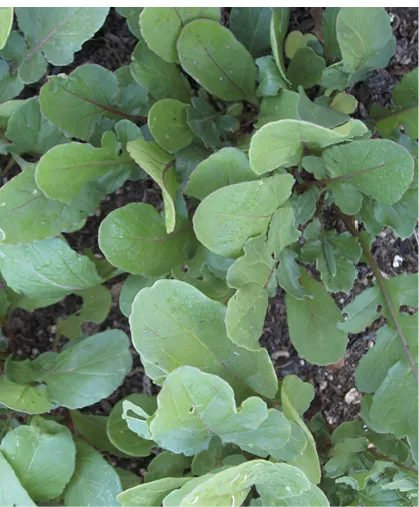![]()
Vegetable Profiles
Now that you have the basics of how to plant from seed and from nursery stock, it’s a good time to talk about specific plants. The next section profiles an array of easy-to-grow vegetables (followed by a section on herbs) that are suitable for small-space gardeners and beginners as well as veteran green thumbs. As you grow your garden, use these plant profiles to help guide your way through the season. Note: Plant spacing is based on biointensive methods. Those using row-farming techniques would space plants farther apart than what is suggested here.
Arugula
Latin name: Eruca vesicaria or Eruca sativa
Seed planting depth: ¼ to ½ inch (6 mm to 1.25 cm)
Plant spacing: 4 to 6 inches (10 to 15 cm)
Soil temperature for germination: 45 to 70° Fahrenheit (7 to 21° Celsius)
Sun: Full to partial
Water: Moderate
Days to germinate: 3 to 7
Days to maturity: 25 to 45
Arugula
About Arugula
Arugula is an annual (see Glossary) plant native to the Mediterranean and has been grown since Roman times, both in the wild and in commercial agriculture. Its leaves are peppery and look similar to radish leaves. The leaves, blossoms, seed pods, and mature seeds of the plant are all edible. Though typically used raw in salads to add a spicy punch to other greens, it can also be cooked with pasta or meats or pureed into a sauce. In traditional southern European dishes, the leaves are also used on pizzas and in pesto.
Growing Arugula
Arugula seed is best sown directly into the garden where you intend to grow it to maturity. Plant the seeds 4 to 6 inches (10 to 15 cm) apart. Gently cover them with ¼ inch (6 mm) of soil and water. Arugula prefers a cool soil temperature and tends to bolt to seed in summer heat, so grow it in the fall/winter and spring seasons. Plant in fertile, loose soil. Water every day until the seeds germinate and then water them as needed to keep the soil moist but not soggy.
Harvesting Arugula
The seeds should sprout in three to seven days (slightly longer in cooler temperatures). For a continuous crop, sow more seeds every two weeks to ensure that new cuttings are available at regular intervals. Arugula matures very quickly—typically within forty days—so get ready to start harvesting in as little as four weeks. Harvest the outside leaves while they are young and tender. The larger arugula gets, the more pungent it becomes. Allow the hardiest plants to bolt to seed and set flowers. When the pods become dry and brittle, carefully remove them from the plant and crush them over a bowl. You will find six to eight seeds in each pod. Place them in a labeled envelope or plastic bag to keep for future use. At the end of the season, pull and compost any remaining plants and roots.
Beans
Latin name: Phaseolus vulgaris
Planting depth: ¾ to 1½ inches (2 to 3.75 cm)
Plant spacing: 4 to 6 inches (10 to 15 cm)
Soil temperature for germin...


